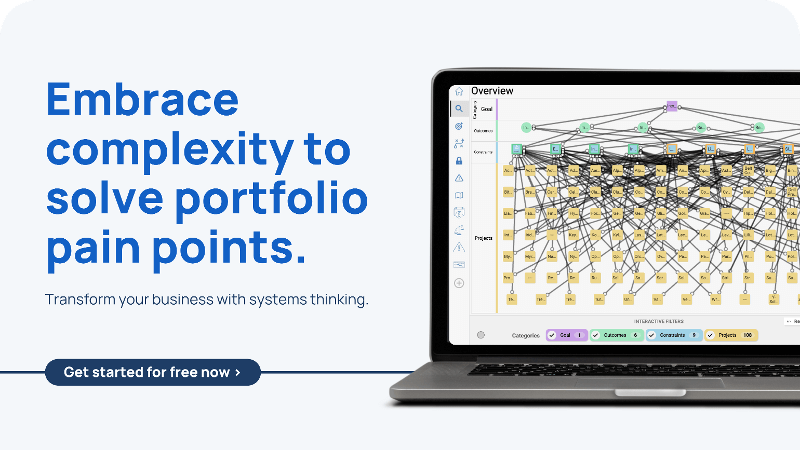With markets constantly evolving, technological advancements accelerating, and an increasing number of global events impacting operations, businesses are facing ever more layers of complexity, threatening to cripple growth and innovation.
In this blog post, we'll explore the cost of complexity and why using a systems approach to managing your data and portfolio is essential for success.
The complexity conundrum
Complexity comes in many forms for businesses. It can arise from diverse product lines, intricate supply chains, convoluted processes, or fragmented data silos. As companies grow and expand their operations, they often encounter a tangled web of interdependencies and inefficiencies that can slow down decision-making, impact cost containment and hinder over all agility to deliver on strategic objectives.
The cost of complexity extends beyond mere inconvenience; it can have tangible impacts on a company's bottom line. Complex systems and processes can lead to increased operational costs, slower time-to-market, reduced customer satisfaction, and missed opportunities for innovation. Moreover, navigating through complexity often requires additional resources and manpower, diverting attention away from strategic initiatives and core business objectives.
Why trying to simplify complexity is not the answer
In the intricate and interconnected world of business, traditional problem-solving approaches often fall short in addressing the complexities organizations face. Many solutions and management processes try to simplify and streamline the system to help reduce costs and inefficiencies, but this often doesn’t make a business more efficient and adaptable.
This is where systems thinking steps in - a holistic approach that considers the interrelationships and dynamics within a system as a whole, rather than focusing solely on individual components or issues.
A holistic view provides leadership with comprehensive insights into every aspect of the business, enabling them to understand dependencies, identify inefficiencies, uncover hidden opportunities, and make informed decisions. By breaking down silos and integrating data from across the organization, businesses can gain a deeper understanding of their operations and the broader market landscape.
Imagine you're managing a small restaurant and you want to optimize your inventory management system to minimize costs while ensuring you have enough ingredients to meet customer demand.
In a system thinking approach, you'd need to consider various interconnected factors such as:
- Customer demand fluctuations based on factors such as days of the week, time of day, weather, promotions, etc.
- Supplier lead times and ordering quantities.
- Shelf life and perishability of ingredients.
- Storage capacity and conditions.
- Production processes and recipe requirements.
At its core, systems thinking is about understanding how these individual components interact to form a larger, interconnected system. Excel can handle basic inventory calculations, but it falls short when it comes to capturing the dynamic and interconnected nature of these factors.
5 ways Excel might struggle managing complexity:
Limited scalability: Excel becomes unwieldy when dealing with large datasets or complex calculations involving multiple interconnected variables.
Difficulty in modeling dynamic relationships: Excel is not designed to easily model feedback loops, delays, and non linear relationships, which are common in complex systems.
Lack of real-time data integration: Excel lacks built-in capabilities for integrating real-time data from external sources, making it challenging to capture up-to-date information on customer demand, supplier availability, etc.
Limited collaboration features: While Excel allows for some collaboration, it's not optimized for concurrent editing by multiple users, which can hinder collaborative problem-solving in a system thinking context.
Difficulty in scenario analysis: Excel makes it challenging to explore different scenarios and simulate the impact of changes in various parameters on the overall system behavior.
Identifying root risks
Rather than treating issues in isolation, this holistic approach encourages businesses to delve deeper to uncover the root causes of problems. By analyzing the underlying structures and dynamics at play, organizations can address dependent issues more effectively and prevent knock-on impacts in the future.
For example, a large defence business had a problem: 75% of all projects were delayed due to inefficient communication, collaboration, and project management practices. These delays were exacerbated by reliance on conventional siloed tools like Excel, leading to human error, misalignments in product roadmaps, and significant financial and operational costs. They needed more visibility across their portfolio.
We offered a comprehensive, visual, and interactive platform designed to:
- Enhance visibility and collaboration: seamless alignment of diverse projects with strategic roadmaps, bolstering both visibility across teams and collaborative efficiency.
- Reduce error and increase fiscal efficiency: transitioning from conventional tools to SharpCloud significantly mitigates the risk of errors, ensuring roadmap accuracy and fostering substantial cost savings.
- Empower decision-making: real-time data views and updates facilitate more informed and agile decision-making processes, driving strategic advancements in R&T activities.
What value did SharpCloud provide?
- Reduced project delays: Anticipated to decrease from 75% to near zero, significantly boosting operational efficiency and adherence to timelines.
- Financial gain: The precision and clarity SharpCloud offers are expected to unlock “tens of millions in savings” by reducing errors and duplications.
- Strategic and operational enhancement: Improved project visibility and enhanced collaboration facilitate strategic alignment and operational excellence, ensuring resources are optimally deployed towards high-value initiatives.
Embracing complexity as a way to solve portfolio pain points
Systems thinking acknowledges the inherent complexity of real-world systems and embraces it rather than attempting to simplify or ignore it. This allows businesses to navigate through complexity more effectively, adapting to changing circumstances and leveraging opportunities that arise from interconnectedness.
Optimize R&D efforts: By identifying and pursuing opportunities with the highest potential for success. Leverage complexity as an opportunity for innovation and strategic decision-making, rather than viewing it solely as a challenge or obstacle. By challenging conventional thinking and exploring new possibilities, organizations can drive innovation and develop more robust strategies for success.
Maximize portfolio value delivery: Effectively align resources and capabilities and easily balance investment between high risk and high rewards opportunities. By considering the portfolio as a complex system, system thinking helps optimize resource allocation by identifying where resources are most needed and ensuring they are allocated strategically to maximize value.
Successfully navigate and scenario plan the challenge: Create a forward looking roadmap and give confidence to decisions on where to grow, pivot, and adjust to maintain competitive advantage. By considering the potential consequences of actions over time, organizations can make more sustainable choices that benefit the system as a whole, rather than focusing solely on short-term gains.
Break down siloed decision making: Systems thinking fosters collaboration and cross-functional teamwork by highlighting the interdependencies between different parts of the organization. By breaking down silos and encouraging communication across departments, businesses can leverage diverse perspectives and expertise to tackle complex challenges more effectively.
Charting a course through complexity
Systems thinking is not just a buzzword, it's a fundamental shift in how we approach problem-solving and decision-making in today's complex and changing environments. It has the power to transform how we understand and interact with the world around us. By embracing systems thinking, companies can unlock new opportunities, mitigate risks, and drive sustainable growth in the face of uncertainty.
SharpCloud offers a range of features and capabilities that make it well-suited for practicing systems thinking. Whether it's visualizing system components, mapping interconnections, analyzing system dynamics, or facilitating collaboration, SharpCloud can help users gain deeper insights into complex systems and make more effective decisions.

